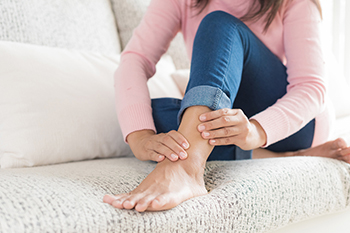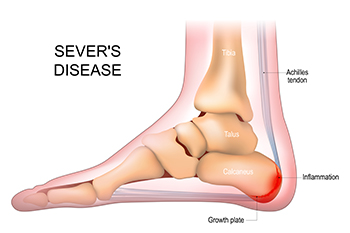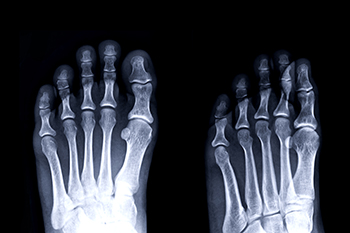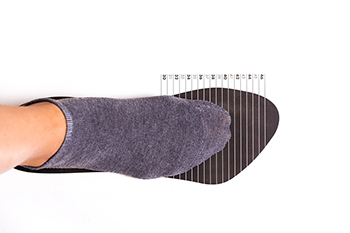3885 S. Decatur Blvd Suite #1080
Las Vegas, NV 89103

Tarsal tunnel syndrome, a condition affecting the posterior tibial nerve in the ankle, unveils a spectrum of symptoms that can significantly impact one's daily activities. Individuals with this syndrome often experience tingling or burning sensations along the inner ankle and sole of the foot. Numbness may extend to the toes, creating a sense of weakness or instability. Pain, resembling an electric shock or shooting sensation, may radiate from the ankle to the arch of the foot. Swelling in the affected area and a noticeable increase in discomfort during extended periods of standing or walking are common indicators. As the symptoms progress, individuals may find relief through rest but experience a resurgence of discomfort upon resuming activities. Recognizing these various signs is critical for a timely diagnosis and intervention. If you are experiencing one or more of these symptoms, it is suggested that you speak with a podiatrist who can diagnose and treat tarsal tunnel syndrome.
Tarsal tunnel syndrome can be very uncomfortable to live with. If you are experiencing tarsal tunnel syndrome, contact Loren Hansen, DPM of Ankle & Foot Medical Center. Our doctor can provide the care you need to keep you pain-free and on your feet.
Tarsal Tunnel Syndrome
Tarsal tunnel syndrome, which can also be called tibial nerve dysfunction, is an uncommon condition of misfiring peripheral nerves in the foot. The tibial nerve is the peripheral nerve in the leg responsible for sensation and movement of the foot and calf muscles. In tarsal tunnel syndrome, the tibial nerve is damaged, causing problems with movement and feeling in the foot of the affected leg.
Common Cause of Tarsal Tunnel Syndrome
The Effects of Tarsal Tunnel Syndrome
A physical exam of the leg can help identify the presence of tarsal tunnel syndrome. Medical tests, such as a nerve biopsy, are also used to diagnose the condition. Patients may receive physical therapy and prescriptive medication. In extreme cases, some may require surgery.
If you have any questions please feel free to contact our office located in Las Vegas, NV . We offer the newest diagnostic and treatment technologies for all your foot and ankle needs.

Sever's disease, a common heel condition among active children, can cause discomfort, but incorporating gentle stretches into daily routines can offer relief. Targeting the calf muscles, a simple standing calf stretch involves placing the affected foot behind the other, pressing the heel into the ground. The soleus stretch, achieved by bending the knee while keeping the heel on the floor, targets the deeper calf muscles. Additionally, the seated hamstring stretch aids in maintaining flexibility in the lower leg. Gentle Achilles stretches, with a focus on controlled movements, can also contribute to easing the tension associated with Sever's disease. Incorporating these stretches into daily activities promotes flexibility and aids in managing discomfort. To prevent exacerbating symptoms, it is important to perform these exercises consistently and avoid overexertion. If your active child has heel pain, it is strongly suggested that you confer with a podiatrist who can diagnose and offer additional relief options.
Sever's disease often occurs in children and teens. If your child is experiencing foot or ankle pain, see Loren Hansen, DPM from Ankle & Foot Medical Center. Our doctor can treat your child’s foot and ankle needs.
Sever’s Disease
Sever’s disease is also known as calcaneal apophysitis, which is a medical condition that causes heel pain I none or both feet. The disease is known to affect children between the ages of 8 and 14.
Sever’s disease occurs when part of the child’s heel known as the growth plate (calcaneal epiphysis) is attached to the Achilles tendon. This area can suffer injury when the muscles and tendons of the growing foot do not keep pace with bone growth. Therefore, the constant pain which one experiences at the back of the heel will make the child unable to put any weight on the heel. The child is then forced to walk on their toes.
Symptoms
Acute pain – Pain associated with Sever’s disease is usually felt in the heel when the child engages in physical activity such as walking, jumping and or running.
Highly active – Children who are very active are among the most susceptible in experiencing Sever’s disease, because of the stress and tension placed on their feet.
If you have any questions, please feel free to contact our office located in Las Vegas, NV . We offer the newest diagnostic and treatment technologies for all your foot and ankle injuries.

The human foot is a marvel of intricate design. A symphony of bones, joints, muscles, and ligaments work in harmony to facilitate movement and provide essential support. Comprising 26 bones, the foot's structural integrity is maintained by an elaborate network of joints that allow for flexibility and articulation. Muscles, spanning from the calf to the toes, create the dynamic movements needed for activities like walking, running, and jumping. Ligaments, sturdy bands of connective tissue, secure bones together, forming stable joints while allowing controlled movement. From the heel to the toes, each component plays a critical role in weight distribution, balance, and shock absorption. The arches, formed by the alignment of bones, contribute to the foot's natural shock-absorbing properties. Understanding this intricate interplay of bones, joints, muscles, and ligaments is essential for appreciating the resilience and versatility of our feet, which serve as the foundation of our daily mobility and physical well-being. If you are having problems with any part of your feet and ankles, it is suggested that you visit a podiatrist who can offer treatment solutions.
If you have any concerns about your feet, contact Loren Hansen, DPM from Ankle & Foot Medical Center. Our doctor can provide the care you need to keep you pain-free and on your feet.
Biomechanics in Podiatry
Podiatric biomechanics is a particular sector of specialty podiatry with licensed practitioners who are trained to diagnose and treat conditions affecting the foot, ankle and lower leg. Biomechanics deals with the forces that act against the body, causing an interference with the biological structures. It focuses on the movement of the ankle, the foot and the forces that interact with them.
A History of Biomechanics
Modern technological improvements are based on past theories and therapeutic processes that provide a better understanding of podiatric concepts for biomechanics. Computers can provide accurate information about the forces and patterns of the feet and lower legs.
Understanding biomechanics of the feet can help improve and eliminate pain, stopping further stress to the foot.
If you have any questions please feel free to contact our office located in Las Vegas, NV . We offer the newest diagnostic and treatment technologies for all your foot and ankle needs.

Choosing the right size footwear for running is pivotal in ensuring a comfortable and injury-free experience. Begin by measuring your foot length and width, considering variations between brands and models. Prioritize a thumb's width of space between your longest toe and the shoe's end to accommodate natural foot swelling during running. Verify that the shoe snugly holds the heel without excessive tightness or slipping. Additionally, assess the arch support and overall fit to align with your foot's unique structure. It is important to try on both shoes, as foot sizes can differ slightly. As you test the shoes, simulate running motions to gauge comfort and stability. Remember that the right size is not solely determined by numerical measurements; it is about finding a shoe that feels secure, and supportive, and allows for the natural movement of your feet. If you would like additional information on how to choose the right shoe size, it is suggested that you consult a podiatrist.
Finding a properly-fitting shoe is important in reducing injuries and preventing foot problems. For more information about treatment, contact Loren Hansen, DPM from Ankle & Foot Medical Center. Our doctor will treat your foot and ankle needs.
Proper Shoe Fitting
A common concern when it comes to foot health, having properly fitted shoes can help prevent injuries to the foot. Out feet affect our posture and gait, which in turn affects the biomechanics and overall bodily structure. With 33 joints, 26 bones, and over 100 ligaments, the potential for serious injury is much greater than one realizes. Although the feet cease growth in adulthood, they still change shape as they mature. Here are some factors to consider when it comes to investing in proper fitting shoes:
Keeping in mind how shoes fit the biomechanics of your body, properly-fitting shoes are vitally important. Fortunately, it is not difficult to acquire footwear that fits correctly. Be sure to wear shoes that support the overall structure of your body. Do your feet a favor and invest in several pairs of well-fitted shoes today.
If you have any questions please feel free to contact our office located in Las Vegas, NV . We offer the newest diagnostic and treatment technologies for all your foot and ankle needs.

Pregnancy is a transformative journey, both physically and emotionally. While many anticipate changes in their bodies, some may not be aware of the potential foot conditions that can arise during this time. One common issue is edema, or swelling of the feet and ankles, which results from increased blood volume and the pressure on leg veins. This can cause discomfort, but it is often temporary. Another condition linked to pregnancy is flat feet. Hormonal changes during pregnancy can affect the ligaments in the feet, leading to a decrease in arch height. This can contribute to foot pain and discomfort. Additionally, weight gain can place added stress on the feet, often causing pain and fatigue. The expanding uterus may also shift the center of gravity, altering the gait and potentially causing problems like plantar fasciitis. Pregnancy can bring about various foot challenges, but with proper care, many of these issues can be managed or prevented. If you have developed any type of foot conditions during your pregnancy, it is suggested that you schedule an appointment with a podiatrist who can monitor any foot pain or discomfort you may be experiencing.
Pregnant women with swollen feet can be treated with a variety of different methods that are readily available. For more information about other cures for swollen feet during pregnancy, consult with Loren Hansen, DPM from Ankle & Foot Medical Center. Our doctor will attend to all of your foot and ankle needs.
What Foot Problems Can Arise During Pregnancy?
One problem that can occur is overpronation, which occurs when the arch of the foot flattens and tends to roll inward. This can cause pain and discomfort in your heels while you’re walking or even just standing up, trying to support your baby.
Another problem is edema, or swelling in the extremities. This often affects the feet during pregnancy but tends to occur in the later stages.
How Can I Keep My Feet Healthy During Pregnancy?
If you have any questions please feel free to contact our office located in Las Vegas, NV . We offer the newest diagnostic and treatment technologies for all your foot and ankle needs.